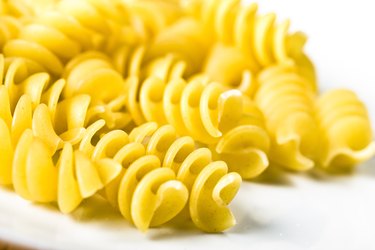
Because your body digests pasta more slowly than many other starchy foods, pasta offers you sustained energy without causing fluctuations in your blood sugar. Pasta's ranking on the glycemic index -- a scale used for rating the effects of foods on blood glucose levels -- may be lower than bread or potatoes, depending on how long you allow your pasta to cook. When using the glycemic index to plan meals, you can include many forms of pasta without increasing the meal's overall effect on your blood sugar.
Glycemic Index
Video of the Day
The glycemic index, or GI, provides a method for evaluating the effects of carbohydrate-containing foods on your blood glucose level. The GI ranks foods on a scale of one to 100 depending on how rapidly and significantly your blood sugar rises after you eat them. Many flour-based products, such as bread, have a high GI value. The GI value of most types of bread ranges between 70 and 75, according to data from the Glycemic Index Foundation. The GI value of pasta ranges between 43 and 61, with values for most types hovering in the mid-50s.
Video of the Day
Molecular Structure
Although pasta, like bread, is made of flour, the structure of the starches in pasta slows digestion, which gives many types of pasta a lower GI than bread. According to the Glycemic Index Foundation, pasta is unique among carbohydrates in that its starch molecules are enclosed in a network of gluten, a form of protein found in wheat. This molecular structure slows the conversion of pasta's carbohydrates into glucose during digestion, which results in a lower GI value.
Types
The type of pasta that you eat, and the length of time that you allow it to boil, affect this food's GI value. Most shapes and sizes of pasta have a GI value between 30 and 60, says the Glycemic Index Foundation. Asian rice noodles such as udon or hokkien also have a low to intermediate GI value. Most forms of pasta may be considered "slow carbs," meaning that their slowly digested carbohydrates provide energy without causing a rapid increase in blood glucose.
Preparation
Overcooking your pasta affects the quality of its starches and can raise its GI value. The more you cook a starchy food like pasta, the more digestible its starches become, which means that your body converts its carbohydrates to glucose more rapidly. To avoid raising pasta's GI value, boil it only until it's al dente, or slightly firm and chewy, suggests the Glycemic Index Foundation.
Recommendations
In a 2002 article published in "The American Journal of Nutrition," Dr. F. Xavier Pi-Sunyer argues that the variability in GI values in the different forms and widths of pasta makes it difficult to make dietary recommendations on this food as a whole based on its glycemic effects. Whether or not you consider pasta's GI value when planning your meals, pasta's complex carbohydrates provide energy with little fat. Try whole-grain versions of pasta, which contain the fiber, vitamins and minerals of the original grain kernels.